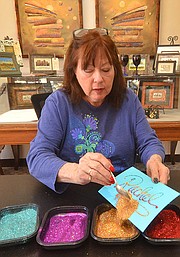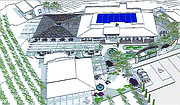The golf course and Ranch House were the Heart, Pride and Joy of Lake Montezuma movers and shakers. Everybody who was anybody had something to do with either the golf course or the Ranch House...or both. Countless thousands of volunteer hours went into "betterment" of the facilities. The facilities were genuine gems. I remember being totally awed by them on my first encounter over 40 years ago.
Some how, some way, something happened and a heartless developer let the golf course die while shuttering the Ranch House, too. A feeble community attempt to resurrect the Ranch House ended with allegations of possible misdeeds. The sad fate of both facilities have lingered like a dark cloud over Lake Montezuma for many years.
The article below brings a ray of hope to the golf course and Ranch House. Of course, in this day and age, sale of such a plum property is fraught with peril. Whether the Glory Days of Lake Montezuma will ever return is a dubious, fanciful flight of fantasy. What's much more likely is a rezoning and massive, high density development--just the thing that will send Lake Montezumians into a froth-at-the-mouth fitful frenzy.
This article appeared in the Easter Sunday issues of "The Verde Independent" and "The Camp Verde Bugle". It is Copyright 2022 by Verde News. It is used here WITHOUT permission because we feel this story transcends the publication's ironclad paywall. This is a story that needs wider circulation in the interest of public awareness and involvement. It's a classic "heads up" story.
Reporter Lo Frisby did a great job writing the article but also gifted the community with an outstanding video of the time-frozen interior of The Ranch House. The video is an instant historical classic! You can watch the 1:28 production here: https://youtu.be/FnBUpClx38k
Original article is below the dashed line:
-----------------------------------------------------
LAKE MONTEZUMA – Beaver Creek Ranch has a long and colorful history, including its years spent as a hidden getaway for famous actors working on films in Sedona during Hollywood’s Golden Age.
Nowadays, it more closely resembles Mrs. Havisham’s mansion in Charles Dickens’ “Great Expectations”: forlorn, neglected, and showing signs of decay.
The contents of Beaver Creek Ranch House have been suspended in time ever since its closure in 2010. Now, it is back on the market and could come back to life.
Realtors Richard Chambers and Sam Worseldine of Camp Verde’s Chambers Realty Group are the listing agents of the ranch, and say the property has many possibilities and they are excited by the thought of it being brought back to life.
“There’s so much potential already,” said Worseldine, who spent summers at the property in his youth.
“The water rights alone have a lot of value," he said.
Chambers said the property’s previous owner had an attorney assess the property’s water rights, which include portions of the historic “Schroeder Ditch,” and it was determined that at the time, there were over 600 acre feet of water.
“The water rights alone justify the ($2.6 million) asking price,” Worseldine added.
Other assets include a restaurant, office building, retail store, and a 1,927 square foot residence.
The golf course, which has continued to receive “basic” maintenance, is over 100 acres.
Chambers and Worseldine say they can envision a vineyard, golf resort, barley farm, boutique hotel, or potentially a combination of things.
“I’d love for it to stay local and see it become what it used to be,” Chambers said.
“It’s a shame that such an icon has been sitting vacant,” Worseldine said.
What about big development?
Chambers explained that despite community rumors of the property being converted into a large-scale development, only a small portion (3.48 acres out of 108) of the property is zoned for commercial use.
The rest of the property is zoned “Open Space,” which can only be utilized for agriculture and cultivation, public or private parks, and other recreational types of spaces like a golf course.
For a larger-scale development to occur, the property would have to first undergo a re-zoning process with the Planning & Zoning Commission, which Chambers said would be a “lengthy endeavor” requiring community input.
“I don’t think it’s likely,” he said.
In addition to rumors of big development, there has been a story going around that the rock ‘n’ roll legend Alice Cooper has taken an interest in the property.
“So far, he hasn’t contacted our office,” Chambers said with a laugh.
“I don’t know how that rumor got started,” he said.
Rumors of Cooper notwithstanding, Chambers and Worseldine say they have received numerous inquiries about the property since it first came on the market a month ago, and are actively engaged in “direct marketing” to local “big name folks” including farmers that they think may be interested.
“Whoever buys it, it’s going to be an improvement,” Worseldine said.
With an active listing posted on Flexmls.com and regular inquiries coming in, it seems it will only be a matter of time until the community knows just what will become of the ranch.
“It’s exciting,” Chambers said.
A historic marker, which was placed by the community, stands at the entrance of Beaver Creek Ranch. Despite its rich history dating back to the 1830s, the ranch is not listed in the Arizona Register of Historic Places.














